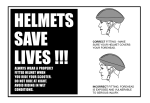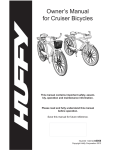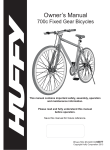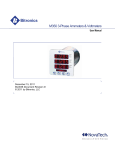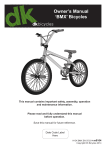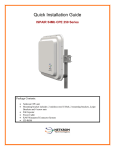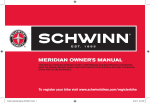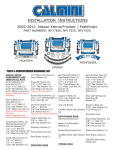Download Stabilizer Wheels Manual
Transcript
Stabilizer Wheels TOOLS REQUIRED The following tools or their equivalently required to complete assembly and the adjustments detailed in the manual ADJUSTABLE WRENCH (4” 8” and 12”) PLIERS OWNER’S INSTRUCTION MANUAL Please direct questions, comments and requests for warranty replacement parts to: Bike USA Inc. 2811 Brodhead Rd. Bethlehem, PA 18020 1-800-225-2453 www.StabilizerWheels.com 1 OWNER’S INFORMATION AND RESPONSIBILITY Throughout the manual you will find WARNINGS, CAUTIONS and NOTES or NOTICES. WARNINGS: Pay special attention to these since failure to do so may result in injury to the rider or others. CAUTIONS: If not followed, these could result in mechanical failure or damage. NOTES or NOTICES: These specify something that is of special interest. It is the responsibility of the person who initially assembles the bicycles to do so correctly and make any necessary adjustments for proper operation. The owner or principle rider is then responsible for normal maintenance of the bicycle to keep it in good operating condition. 1. Make certain that all assembly instructions and necessary adjustments have been followed. 2. Perform the safety check list and mark each item listed. 3. Know how to operate all standard and accessory equipment on the bicycle. 4. Make sure that anyone who uses the bicycle has been fully instructed in its operation. 5. Your bicycle conforms to all Federal CPSC regulations. There may be other federal, state or local regulations, restrictions or equipment laws: therefore, you should make sure your bicycle complies with all applicable regulations before it is ridden. BIKE USA STABILIZER WHEEL SET We hope you enjoy using your new Bike USA Stabilizer Wheel Set. It was designed to add versatility and safety to your riding experience. It was designed to be attractive and easy to use. It will fit most bicycles with a 24 to 27 inch wheel diameter. Bike USA understands that the need and hope of today’s physically challenged to have as normal and complete lifestyle as possible. No longer does the handicapped child or older adult have to “sit on the sidelines”. INCLUDED PARTS IDENTIFICATION 1) twelve locking nuts 2) four short u-bolts 3) two long u-bolts 4) two extra long u-bolts (for alloy frame bicycles only) 5) two stabilizer brackets 6) two wheels with tires 7) six steel spacers 8) four plastic thin spacers 9) four plastic thick spacers 2 ASSEMBLY INSTRUCTIONS Step 1: Remove the brackets from their packaging and place on either side of the bike. Each bracket is different and should have the BIKE USA stamped logo facing forward when the bracket plate is against frame. Hold against bike to check correct placement. Step 2: Start by placing the short u-bolt on the seat stay (upper frame tube) of the frame and slide the thin plastic spacer over the u-bolt up against the frame. (Note: ubolts come in three sizes; small, long and extra long. Plastic spacers come in two sizes; thin and thick) Step 3: Place the bracket against the frame. Align the u-bolt ends to be approximately in the center of the top grove on bracket. (Note: slide u-bolt and bracket up and down frame to align bottom row of holes on bracket so it is slightly below frame chain stay (lower frame tube)). Step 4: Place the steel spacer over the ends of the u-bolt and up against the bracket. (STOP: double check you have used the correct sized parts, in this order: short u-bolt, thin plastic spacer, stabilizer bracket, then steel spacer). 3 ASSEMBLY INSTRUCTIONS Step 5: Loosely tighten the nuts on the ends of the u-bolt. Do not tighten down yet. (Note: the stabilizer bracket should be against the frame of the bike, with the Bike USA logo facing forward, and the bottom slots slightly below the level of the frame chain stay (lower frame tube)). Step 6: From behind the stabilizer bracket, put the short u-bolt around the frame chain stay (lower frame tube) and through the rear bottom slots in bracket. Lift the bracket up slightly, place a thin plastic washer between frame tube and bracket. Then put u-bolt through bracket again. Place a steel washer over u-bolt ends up against bracket face. The order of u-bolt and spacers should look identical with the set on the upper frame seat stay (upper frame tube). Step 7: From behind the stabilizer bracket, put the long u-bolt around the frame chain stay (lower frame tube) and through the front bottom slots in bracket. Lift the bracket up slightly, place a thick plastic washer between frame tube and bracket. Then put u-bolt through bracket again. Place a steel washer over ubolt ends up against bracket face. (STOP: double check that you used a long u-bolt and thick plastic washer). Loosely tighten the nuts on the ends of the ubolt. Do not tighten down yet. Step 8: Pick up one of the wheels. (Note: you should have two of the same wheel). Remove the axle nuts and retaining washers. Place the wheel in between the stabilizer bracket fork ends, with axle resting in the fork ends. 4 ASSEMBLY INSTRUCTIONS Step 9: Slide retaining washers over each side of axle and hook into little hole on fork end. (Note: the retaining washer helps hold the wheel from falling off in the event of a loose nut). Loosely tighten the nuts on the ends of the axle. (STOP: double check that each side retaining washer is hooked into the fork hole). Visually check that the wheel is centered evenly in the fork, then tighten down the axle nuts completely. Step 10: With the bike standing completely upright, slide the bracket on the frame forwards or backwards, raising or lowering the whole assembly, until the stabilizer wheel is ½” off of the floor surface. (Note: the stabilizer wheels should not be touching the ground when the bike is upright, but should touch the ground when the bike is leaned slightly left or right). Step 11: Securely tighten down all six lock nuts on the end of the u-bolts. (Caution: all nuts and bolts on the stabilizer bracket, stabilizer wheel and bike need to be double checked for tightness. Loose nuts could result in unsafe riding). Step 12: Repeat steps 1 – 11 of the bracket assembly on the other side of the bike. When complete, both wheels should be ½” off of the ground. Both brackets should be level and both wheels should be parallel with the rear wheel of the bike. Double check all assembly, tightness of lock nuts, and safety washers. Your assembly is complete and bike is ready to ride. 5 SAFETY CHECKLIST Even under the best of circumstances, bicycling can be a hazardous activity, and as in many recreational activities, accidents can and do occasionally occur. It is for this reason that we specifically bring the following safety points to your attention. We ask that you read each point carefully; if you do not clearly understand any particular point addressed, please call our 800 number for additional information. Perform each check below after all the assembly instructions and any necessary adjustments have been completed. q 1. STEERING: Make certain that the stem is inserted into the head tube to at least the minimum insertion line. Check the clamp nut and stem bolt to make sure they are tightened securely. (See the handlebar and stem assembly sections for recommended torque.) q 2. BRAKES: Check and adjust, if necessary (See the brake adjustment section.) WARNING: Before riding, activate front and rear brakes 20 to 25 times, and then make final brake adjustments. This procedure takes care of the initial cable stretch. q 3. SEAT: Check for tightness of the seat clamp and the seat post clamp and that the minimum insertion line is inside the frame. See that the seat is at the proper height for the intended rider. (See the seat assembly section) q 4. PEDALS: Check the pedal spindles, making sure that they fit tightly against the crank arms. (See the pedal assembly section for recommended torque.) q 5. TIRES: Check and inflate, using a hand pump if necessary. The correct pressure is marked on the side of the tire. DO NOT OVER-INFLATE. q 6. GENERAL INSPECTION: See that all reflectors have been properly installed. Replace any missing or damaged reflectors. Check all fasteners and tighten, if necessary. q 7. TO THE RIDER OF THIS BICYCLE: Make certain that you know how to operate the bicycle. We recommend that you read all safety and warning information in the manual before riding. q 8. WHEEL QUICK RELEASE: If the wheels are equipped with Quick Release Hubs, make sure they are properly tightened. Check the procedure in the manual. q 9. HELMET: I understand that all riders (adults and children) should wear a bicycle helmet whenever riding the bicycle. q 10. LAWS: I understand that this bicycle is subject to all the laws of the road, and that many states and localities have additional laws which specifically apply to bicycles. I understand that it is my responsibility to make myself familiar with and to observe these laws. q 11. LIGHTS: I understand that riding this bicycle at dawn, at dusk, after dark or at times of poor visibility, is extremely dangerous and I understand that it is my responsibility to equip the bicycle with an appropriate lighting system, which meets or exceeds local and state law requirements before I ride the bicycle under these conditions. q 12. MAINTENANCE: I understand that regular maintenance is required to keep this bicycle operating properly, and that failure to maintain it may void the manufacturer’s warranty and may make the bicycle unsafe. Regular maintenance includes frequent inspection of all quick release mechanisms and wheel retention devices and maintaining the recommended tire pressure as marked on the tire. q 13. EQUIPMENT: I understand that the manufacturer of this bicycle has incorporated many components in its design which are important to the safe operation of the bicycle. I understand that removing, modifying or replacing any original equipment components may result in making the bicycle unsafe. MAINTENANCE Your bicycle will require regular maintenance. Although simple in most cases, there are times when the repairs and adjustments take special knowledge and proper tools. We recommend that when service is required, you should have a qualified bicycle repairman do it for you. RECOMMENDED GENERAL MAINTENANCE SCHEDULE To maintain the original brilliant painted and chrome finish, keep your bicycle clean and dry. Wipe off dirt, moisture and oil with a clean, soft cloth. Periodically, polish with a clear coat of wax. WARNING: Do not use a wax polish or oils of any kind on the rims of your bicycle. In order for the caliper brakes to operate properly, the rims should be kept clean and free of dirt and lubricants. Due to wear of new parts, we recommend that you inspect the bicycle frequently for adjustment of brakes, bearings, wheels, etc. Adjust or tighten nuts and screws. The frequency of inspection would depend on how much and how hard you ride. Normally, we recommend an annual service check. Any 6 (General Information For All Bicycle Owners) (General Information For All Bicycle Owners) component that does not function properly should be checked and corrected immediately. If you do not feel qualified to make the adjustment, we recommend that you take your bicycle to a qualified bicycle repairman. REAR WHEEL REMOVAL 1. Place bicycle upside down, resting it on the seat and handlebars. Cushion handlebars to prevent damage to stem shifters and caliper brake levers. 2. If necessary, remove one caliper brake shoe to allow clearance for the wheel removal. 3. Shift chain onto the small sprocket. 4. Remove the axle nuts and washers from both sides of the axle. 5. Pivot the derailleur to the rear of the bicycle. Guide the wheel out of the frame and remove the chain from the sprocket. 6. Remove the wheel from the frame. Release the derailleur. WARNING: For your safety, read, understand, and obey these rules of the road. RULES OF THE ROAD 1) In the interest of safer cycling, make sure your read and understand your owner’s manual. 2) NOTICE: Some state and local laws may require that your bicycle be equipped with a warning device such as a horn or bell and light, if the bicycle is to be ridden after dark. 3) ALWAYS WEAR SHOES when riding a bicycle and AVOID loose fitting clothing. 4) CHECK YOUR BREAKS FREQUENTLY. The ability to stop your bicycle is CRITICAL. Roads are SLIPPERY in wet weather, so AVOID sharp turns and allow more distance for stopping. Caliper breaks may become less efficient when wet. Leaves, loose gravel, and other debris on the road can also affect the stopping distance. 5) The kickstand is designed to support the bicycle only, not the bicycle and rider. 6) REPLACE bent or BROKEN spokes and bent or damaged wheel rims. 7) OBEY ALL TRAFFIC REGULATIONS. Most traffic regulations apply to bike riders as well as automobile operators. 8) KEEP TO THE RIGHT. Follow the traffic flow in a straight line close to the curb. Watch for cars moving in and out of traffic. 9) NEVER CARRY RIDERS. Only a properly installed child carrier is acceptable, if it used safely. 10) WHEN RIDING IN PAIRS or in large groups, form a single line along the right side of the road. Set up a sensible distance between riders. DON’T TAILGATE. 11) ALWAYS BE ALERT. Animals or people may dart in front of you. Be on the ALERT-people have the right-of-way. Be ALERT to people opening doors when passing parked cars. Your bicycle was not designed for stunting and experimentation. Enjoy riding it in a safe manner. 12) BE CAREFUL AT ALL INTERSECTIONS. Slow down and look both ways before crossing. 13) USE HAND SIGNALS. Always let other drivers and pedestrians know what you are going to do. Signal 100 ft. before turning unless your hand is needed to control the bike. 14) HAVE PROPER LIGHTS AND REFLECTORS. Never ride at night without a white front reflector and headlight, a red rear reflector and light and wheel reflectors. Other devices, like flags and reflective tape, also help you become more visible. 15) DO NOT CARRY PACKAGES or OBJECTS which obstruct vision, restrict control or could get entangled in the spokes. 16) NEVER HITCH RIDES. Never hold onto a moving vehicle while riding. Never “stunt” 17) AVOID the following HAZARDS: Drain grates, pot holes, ruts, soft road edges, gravel, sand and leaves especially when they are wet. SAFETY WARNINGS Before you ride, please read all of the following items making sure you understand them. Failure to do so could cause damaged to the bicycle or possible injury to yourself or others. Your bicycle meets or exceeds industry standards. It is NOT designed for off-road use, jumping, stunts and other types of abusive riding. ALWAYS WEAR A HELMET! BRAKE PRECAUTIONS: 1) Do not ride the bicycle until you have checked for proper brake adjustments. 2) When riding your bicycle for the first time, test the brakes at a slow speed on a large level surface without obstructions. Also, never attempt to stop suddenly using the front brake only, as this could throw the rider off the front of the bicycle. 3) Check and adjust the brakes, if necessary at the first sign of failure. This will enable the rider to make a quick and smooth stop. On caliper brakes, if a brake lever touches the grip when it is squeezed, adjust the brakes. 4) Going downhill fast is dangerous since you can’t stop nearly as fast as you can on level ground. A curve at the bottom of a hill could force you into oncoming traffic or off the road if you are going at an excess speed. 5) Use the front brake slowly and carefully, especially while turning or when the road is wet or covered with gravel, sand or leaves. Start braking sooner under these conditions and with less force to reduce the chance of skidding. Wet brakes shoes mean that this will require more distance to stop. Start braking sooner than normal in wet conditions. (General Information For All Bicycle Owners) (General Information For All Bicycle Owners) 6) NIGHTTIME RIDING: a) You can’t see the controls on your bicycle at night, so you must know where they are by touch. b) Slow down. Debris and holes are much harder to see at night. c) If possible, ride on streets that are familiar to you. Terrain that you have never seen during the day is dangerous at night. d) Use well lighted streets whenever possible. Avoid unlighted bike paths. e) Comply with all legal requirements in your state. You must at least have a “white light”, (not just a white reflector), on the front and a rear red light. All states require that a lamp that emits a white light be used. f) Children generally should not be allowed to ride a bicycle at night and adults should avoid night riding, if possible. g) Always wear a helmet, and it is a good idea to have a rear view mirror. 7) If the stem is not inserted into the head tube to at least the minimum insertion line, or if the stem bolt is over tightened, the fork could become damaged. This could cause an unsafe condition and risk of injury to the rider. 8) For safe operation, the handlebar stem bolt and clamp nut must be securely tightened. Check them often. 9) For safe operation, you must secure the pedal spindle tightly against the crank arm with a wrench that fits the shoulder of the pedal spindle. This is important; it avoids stripping the threads. Always replace damaged pedals. 10) When adjusting the seat height, you must have the minimum insertion mark on the seat post remaining inside the frame. 7 Limited Warranty 1) Warrantee: This warranty applies only to the original retail purchaser and is not transferable. 2) The Stabilizer is warranted to be free from defects in materials and workmanship under normal use of the Stabilizer for the lifetime of the Stabilizer. 3) Defective Parts: All original parts, except tires, and tubes, are warranted for one year from the date of purchase. During the warranty period, all original parts, as determined by the manufacturer found to be defective in workmanship or material, will be repaired or replaced free of charge, except for shipping and dealer labor charge. 4) Warranty Exclusions: This warranty does not cover failure due to accident, abuse, neglect, normal wear, improper assembly, improper fit, or use of unauthorized replacement parts. This warranty does not cover any personal injuries, damage or failure of the bicycle if it is used in any competitive event, including bicycle racing, motocross, stunt, or similar activities or when in training for the above. Motors or other accessories inconsistent with normal use will negate this warranty. 5) This warranty is expressly in lieu of any other written warranty and/or any implied warranty including any warranty of merchantability or fitness and is limited in duration to the conditions specified in this warranty. (Some states do not allow a limitation on how long an implied warranty lasts, so the above limitation may not apply to you). 6) We shall not be responsible for consequential or special damages, nor for transportation charges or for dealer labor charge except as set for above. 7) This warranty gives you specific legal rights, and you may also have other rights which vary from state to state. Please direct questions, comments, and requests for warranty replacement parts to: Bike USA Inc. 1-800-225-2453 8








